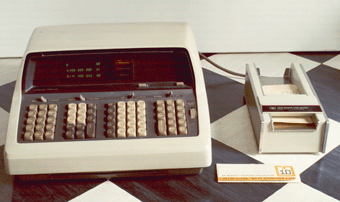HP 9100A, 9100B Programmable Calculators
UvA Computer Museum catalogue nrs 07.14, 01.43

The control logic uses 64 29-bit words of core ROM. Depending on whether a word line (one out of 64) is threading or passing one of the 29 cores (in fact small transformers), a pulse is generated or not in the core's output winding when the clock source sends a current pulse over the word line.
Finally, there are 2208 bits of 'standard' coincident-current core memory (arranged as 6*16*23) implementing the machine's RAM.
In our collection we also have an HP9100B (1969), which has twice the amount of RAM of the original HP9100A, described above. Furthermore we have the 9150A monitor scope: a large (and heavy) 19" analog monitor showing the register stack on a scale suitable for lecture room demonstrations. The 9160 optical card reader too was mainly intended for classroom use, mark-sense cards being a cheap replacement for magnetic cards.
The HP9100A calculator was donated by Walter Frankvoort. The HP9100B, together with peripherals, software and documentation was donated by Mr. L. van Stratum, Eindhoven, The Netherlands.
Many details about the HP9100A can be found in Bell and Newell (eds): 'Computer Structures: Readings and Examples', MacGraw-Hill 1971.
